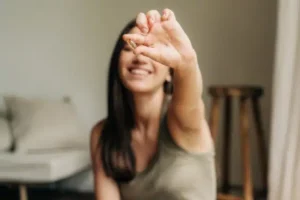October is Breast Cancer Awareness Month and that means – whether you’ve checked your breasts before or not – it’s time to get in touch.
Cancer is a scary word, but it’ll only get scarier the less we face it. Looking breast cancer straight in the eye is what this month is all about. We’re here to walk you through the what, who and how of breast cancer so that you can all keep yourself and your loved ones as safe as possible all year round.
The likelihood of getting breast cancer increases with age. That’s why all women between 50 and 71 are offered a breast cancer screening every three years by their GP. But if something doesn’t look or feel quite right, don’t wait to be invited for a screening. Come and see us and we’ll get you checked.
Do I need to check myself for breast cancer?
Breast cancer is the most common type of cancer in the UK. About one in eight women are diagnosed with breast cancer during their lifetime.
These statistics are alarming, but it’s important we recognise them so that we have the best possible chance of avoiding breast cancer. The good news is that, if it’s detected early, treatment can be very effective and there’s more than a good chance of survival.
Four out of five people diagnosed with breast cancer are women over 50, which is why that group are offered screenings. But that doesn’t mean that younger women and men cannot get breast cancer. We’ve all got breast tissue, so we can all get breast cancer. It’s really important that everyone – and we mean everyone – learns how to check themselves.
How do I check myself for breast cancer?
In order to keep a proper eye on your breasts, you need to check them regularly. We suggest having a feel of them about once a month. If you’re female, it’s crucial that you check your breasts at the same time every month as your menstrual cycle will change how they look and feel.
Starting with your nipple, feel around in a spiral until you’ve covered your whole breast. Make sure you don’t forget under your armpits and around your collarbone – breast tissue stretches all the way up there too.
The most important thing is to learn what’s normal for you. If anything changes, that’s when you should get in touch with a doctor.
What should I look out for?
- Lumps or swelling in the breasts, armpit or around the collarbone
- Changes in the size or shape of one or both breasts
- Changes to your nipples, such as inversion or discharge
- Changes in skin texture, such as puckering or dimpling
- Red inflammation or rashes around your nipples
- Consistent or unusual pain in your breasts
If you’re unsure, get it checked
Around 90% of breast lumps don’t lead to breast cancer, so there’s no need to panic. But if you’re at all concerned, it’s best to get a doctor to have a look at it.
We get that having your breasts checked by a doctor can be uncomfortable. If you’d rather see a female GP, just ask and we’ll make sure to arrange that. We’re here to put your mind at ease, not to add more stress.
And remember, cancer doesn’t stop for Covid-19. So, check your breasts regularly and don’t hesitate if something’s wrong. Because pandemic or no pandemic, we’re still here and putting your health – all of your health – first.



